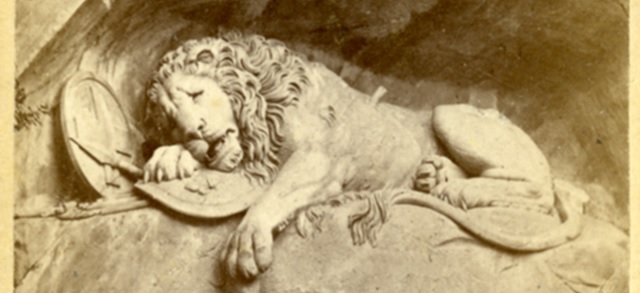
Monuments Class Projects
Architect/Sculptor of Monument
Denis Foyatier (1793-1863)
Preview

Medium
photograph, carte-de-viste
Keywords
Joan of Arc, Jeanne d'Arc, Equestrian statue, Joan of Arc equestrian statue, Orleans, Martyr, Patron Saint of France, Siege of Orléans, Sculpture, Neoclassical Sculpture, Neoclassicism, Hundred Years War, Denis Foyatier
Physical Dimensions
4 x 2.5"
Date of Publication
c. 1868-1900
Name of Monument
Equestrian Statue of Joan of Arc
Date of Creation of Monument
1855
Date of Completion or Dedication of Monument
1855
City of Monument
Orléans
Location within City
Place du Martroi
State/Province of Monument
Centre-Val de Loire
Country of Monument
France
Description
This neoclassical sculpture by Denis Foyatier (1793-1863) is located in Place du Martroi, in the center of Orléans, France. The statue commemorates France’s Patron Saint for her deeds and sacrifice, particularly her victory during the Siege of Orleans(1428-1429). The statue depicts Joan of Arc (c.1412-1431) riding a horse with her sword pointing flat rather than upward, as is more common in equestrian statues of military heroes.
School of Art/Architecture
Neoclassical
Publisher
Ricmou, Orléans



Comments
The Equestrian Statue of Joan of Arc was created in 1855 by the famous sculptor Denis Foyatier (1793-1863). It commemorates the patron saint of France, Joan of Arc (1412-1431).
Joan of Arc was born to a farming family in the village of Domremy. She was often described as pious, well-mannered, religious, and someone who seemed mature beyond her years. It was around the age of thirteen (1425) that Joan of Arc claimed that she began to hear voices and visions who would later which be identified as saints and angelic figures. Around 1428, Joan of Arc rose in importance during the Hundred Years’ War (1337–1453). At this time, the city of Orleans was under siege by an English army led by the Earl of Salisbury, which gave Joan of Arc her chance to rise to prominence. After Joan's victory here, she was sent to the city of Poitiers in order to prove and test her orthodoxy. Following this, Joan begin to be labeled a living saint as word spread. Joan of Arc’s first claim to fame was her role in lifting the Siege of Orleans.
The Siege of Orleans (October 12, 1428 – May 8, 1429) has been described as “one of those events on which depend the fate of empires.” Joan played a major part in the ongoing siege of Orleans. She also played a part in the negotiations and took part in the battle, although not through direct combat. Joan of Arc's deeds during this siege, the other military efforts, and her death after betrayal by being burned at the stake all cemented her legacy as a national hero.
Joan of Arc's legacy lived on, and on May 16, 1920, Joan was canonized and made the Patron Saint of France by Pope Benedict XV. The Equestrian Statue of Joan of Arc in Orleans was dedicated in 1855 to commemorate her accomplishments in the defense of Orleans an of France as a whole. Sculptor Denis Foyatier (1793-1863) created this Neoclassical statue. The statue is set on top of a pedestal. Joan of Arc sits on horseback with a sword in hand. She wears very intricate armor and unlike many other statues of military heroes, Joan is shown holding a sword pointing down and flat, rather than up in the air. This is in reference to Joan is giving the glory of her victory to God rather than attributing it to her own heroic actions. The statue is said to have been made out of English cannons. On the front of the statue, there is an inscription that reads: “Fondu par Saint Denis 1855” which translates “Cast by Saint Denis 1855”. An inscription on the pedestal reads: “A Jeanne d’Arc/ La ville d’Orléans / Avec le concours de la France entière”, which translates as "To Joan of Arc / From the city of Orléans / With the coucurrence of the whole of France".
The Equestrian statue of Joan of Arc is located in the Place du Martroi, the center of Orléans. The square is surrounded by historical buildings and is an attraction with a carousel, festivals, and multiple restaurants in the area This center is significant historically not only because of the famous siege, but also for later historical events. The town center and the statue were damaged in 1944 during World War II. The damage to the statue was repaired in 1950. After the statue was restored, an inscription was added on the statue that read: “Cette statue gravement endommagée au cours de la deuxième guerre mondiale a été restaurée en 1950 grâce à la générosité des habitants de la nouvelle Orléans,” meaning “This statue, was seriously damaged during the Second World War, was restored in 1950 thanks to the generosity of the inhabitants of New Orleans.".
Bibliography
Burne, Alfred H. “XIV. THE SIEGE OF ORLEANS.” In The Agincourt War. United States: Pen & Sword Books Limited, 2014.
“Foyatier - Spartacus.” Martin du Louvre Gallery - Paris - Modern and Contemporary Art, April 9, 2018. https://www.martindulouvre.com/artists/foyatier-spartacus/.
“La Statue de Jeanne Sur La Place Du Martroi à Orléans. | Célébrer Jeanne d’Arc Sous Le Second Empire.” Univ-Poitiers. Accessed February 19, 2025. https://blogs.univ-poitiers.fr/seminaire1/la-fete-de-jeanne-darc-a-orleans-en-1855/la-statue-de-jeanne-sur-la-place-du-martroi-a-orleans/.
“St. Joan of Arc.” newadvent, 2023. https://www.newadvent.org/cathen/08409c.htm.
“Statue de Jeanne d’arc • A Symbol of Courage in Orleans.” FranceRent. Accessed February 19, 2025. https://francerent.com/destinations/Caen/attractions/statue-de-jeanne-d-arc?srsltid=AfmBOorC2jiQEpRSB61Id_-Bif5b7_kpn8mzeyJRFeeqemYnz3NLWawK.
Richards, Laura Elizabeth Howe. Joan of Arc. Project Gutenberg, 2014.
Tilburg, Kees Van. “Equestrian Statue of Jeanne d’Arc in Orléans France.” Equestrian statues, October 14, 2020. https://equestrianstatue.org/jeanne-d-arc-8/.
“Walking in Joan of Arc’s Footsteps.” Orléans Val de Loire Tourisme, January 3, 2022. https://www.tourisme-orleansmetropole.com/en/visit-orleans-get-inspired/must-sees/walking-in-joan-of-arcs-footsteps/#:~:text=Place%20du%20.
Williamson, Allen. “Joan of Arc Archive.” Joan of Arc Biography. Accessed February 19, 2025. https://archive.joan-of-arc.org/joanofarc_short_biography.html.